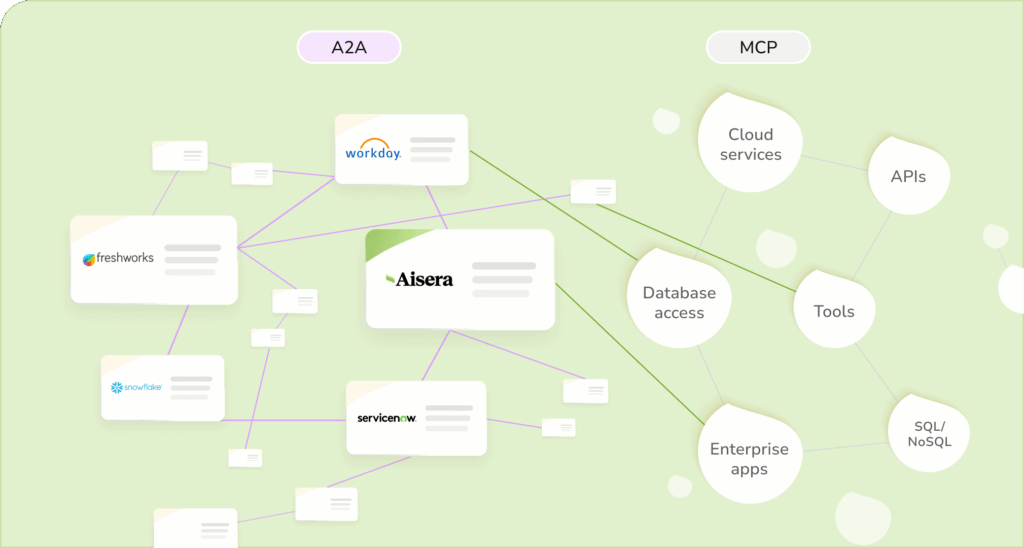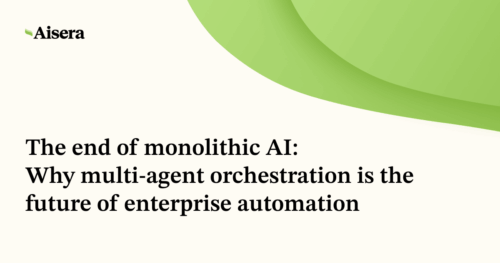What is Multi-Agent Orchestration?
Multi-Agent Orchestration is the architectural framework that coordinates multiple specialized AI agents to work together as a unified system. Rather than relying on a single “monolithic” model to handle every task, orchestration assigns specific sub-tasks—such as data retrieval, code generation, or compliance checking—to the agent best suited for that specific role.
While the enterprise AI revolution has promised breakthrough productivity, many CIOs have found that monolithic systems deliver only incremental improvements. This is often because single-agent platforms are “jack-of-all-trades” solutions that lack the depth required for complex enterprise workflows.
Multi-Agent Orchestration solves this by shifting the architecture from generalist to specialist:
- Monolithic AI: A single, all-encompassing model attempts to handle IT, HR, and legal queries simultaneously, often creating bottlenecks and hallucination risks.
- Orchestrated Agents: A central “brain” or orchestrator breaks down complex requests and routes them to specialized agents (e.g., a “Legal Compliance Agent” or a “Financial Approval Agent”).
By enabling these agentic AI systems to collaborate and share context, enterprises can move beyond simple chatbots to fully autonomous workflows that are scalable, auditable, and highly accurate.
The Monolithic AI Problem: Why Single Agents Hit the Ceiling
Monolithic AI systems promise simplicity but deliver complexity in disguise. These platforms attempt to compress the entirety of enterprise knowledge and processes into a single agent, creating inherent limitations that become apparent as organizations scale their AI initiatives.
Consider a seemingly straightforward IT service request: “Set up the new marketing manager with appropriate access.” A monolithic system must understand HR policies, IT security protocols, application provisioning workflows, and compliance requirements – all while maintaining context across multiple backend systems. The result is either a brittle web of point-to-point integrations that break under pressure or frequent escalations to human operators that erode ROI.
The economics are equally problematic. Massive foundational models excel at complex reasoning but are overkill for routine tasks. When a monolithic agent uses a 175-billion-parameter model to reset a password or check vacation balances, organizations burn compute resources inefficiently. Fine-tuning these behemoths for every possible enterprise scenario becomes prohibitively expensive and technically impractical.
Our research shows that enterprises consistently hit the ceiling of monolithic agents within 6-12 months of deployment. The telltale signs are clear: increasing integration costs, declining accuracy on domain-specific tasks, security blind spots in cross-system workflows, and the inability to adapt quickly to new business requirements. Single points of failure cascade across the entire system, and vendor-locked roadmaps prevent organizations from adopting new models or capabilities as they emerge.
The breaking point comes when organizations realize they need governance and compliance controls that vary by region, department, and data sensitivity level. A monolithic agent designed for general use cannot simultaneously comply with GDPR in Europe, handle PII redaction in finance, and manage zero-trust security protocols in IT – at least not without becoming unwieldy and unreliable.

The Multi-Agent Paradigm Shift: Orchestrated Intelligence at Scale
Aisera aims to solve the problem of fragmentation with Aisera Unify. The solution mirrors the architectural evolution that transformed software development: the shift from monolithic applications to microservices. Just as distributed systems replaced single-server architectures, multi-agent orchestration is replacing monolithic AI platforms.
With Aisera Unify, specialized agents with domain expertise work in concert, each optimized for specific tasks and business contexts. An IT agent understands infrastructure and security protocols. An HR agent knows policies, benefits, and compliance requirements. A finance agent handles approvals, budgets, and reporting. Rather than forcing one agent to master everything, each agent excels in its domain while collaborating through standardized communication protocols.
This architectural shift enables real-time collaboration and reasoning between agents. When that marketing manager needs system access, the HR agent validates the role and determines appropriate permissions, the IT agent provisions the accounts and applies security policies, and the finance agent approves any associated costs – all autonomously, with each agent contributing its specialized expertise.
The technical foundation relies on emerging standards like Agent-to-Agent (A2A) communication protocols that enable seamless coordination across AI systems. The Model Context Protocol (MCP) ensures context sharing across applications and agents, while dynamic agent discovery mechanisms allow new capabilities to be added without disrupting existing workflows.
In fact, Unify supports all four core strategies of agent context engineering – write, select, compress, and isolate- to ensure memory persistence, contextual relevance, efficient token usage, and secure, sandboxed execution across agent sessions and systems with MCP.
The agentic orchestration follows a closed-loop reasoning pattern: discover available agents, plan the optimal workflow, reflect on intermediate results, and execute the coordinated response.
This approach delivers fault tolerance and graceful degradation that monolithic systems cannot match. If the finance agent experiences issues, the workflow continues with appropriate fallbacks rather than grinding to a halt. Agents can be updated, replaced, or enhanced independently without requiring full system regression testing.
The vision extends beyond simple task automation to true collaborative intelligence. Agents learn from each other’s successes and failures, sharing insights that improve collective performance. They anticipate needs based on cross-domain patterns, suggesting proactive actions rather than merely responding to requests. Most importantly, they operate with human oversight rather than micromanagement, escalating only when human judgment is genuinely required.

Architecting the Future: Open Standards-Based Orchestration
While the industry debates incremental improvements to existing chatbots and copilots, forward-thinking organizations are architecting the communication backbone for enterprise AI. The key insight is that future-proof enterprise AI architecture requires an open standards-based orchestration platform that works with any LLM, any agent, and any system.
This universal agent platform addresses the fundamental challenge of vendor lock-in that plagues current AI implementations. Organizations need the freedom to adopt new models as they emerge, integrate best-of-breed agents from multiple providers, and evolve their AI capabilities without being constrained by a single vendor’s roadmap or limitations.
The architecture centers on several critical components. An intelligent LLM Gateway routes tasks to the most appropriate foundational models across the agent ecosystem, optimizing for accuracy while minimizing latency and compute costs. A robust security framework ensures that AI agents operate transparently and comply with enterprise-wide data and security policies. Built-in observability provides full transparency into agent interactions, decision-making processes, and performance metrics.
Technical credibility comes from supporting emerging industry standards, including A2A, MCP, and AGNTCY protocols. This standards-based approach enables plugin ecosystems where third-party agents can be seamlessly integrated, enterprise security and compliance requirements are built into the foundation, and the platform scales from pilot projects to enterprise-wide deployments without architectural rewrites.
As Aisera CEO Abhi Maheshwari observes, “Enterprises juggle dozens of tools, platforms, and ecosystems – but each one often operates in its own silo. The future belongs to platforms that break down these barriers by serving as the connective tissue between AI agents and real business workflows. Instead of agents stuck in isolated apps, truly autonomous systems let them work together without manual hand-offs. This is the foundation for multi-agent collaboration and execution across any system, domain, or vendor – showing what real agentic autonomy looks like at enterprise scale.”
The platform services that support this ecosystem include shared access to enterprise databases, vector stores, metadata repositories, and knowledge graphs. These services power pattern recognition, analytics, and continuous feedback loops that improve agent performance over time. Most importantly, they provide the governance and auditability that enterprise leaders demand.
The Strategic Imperative: Why Timing Matters
The shift to multi-agent orchestration represents more than a technological upgrade – it’s a strategic imperative that will separate industry leaders from laggards. Organizations that recognize this transition early will gain significant first-mover advantages in operational efficiency, customer experience, and competitive positioning.
The cost of waiting is measured not just in missed opportunities, but in the increasing expense of maintaining brittle, monolithic systems that become more difficult to integrate and upgrade over time. While competitors gain truly autonomous capabilities through orchestrated agent systems, organizations stuck with legacy AI approaches will find themselves at an insurmountable disadvantage.
Enterprise leaders must start planning their transition now. The technical architecture decisions made today will determine whether organizations can adapt quickly to new AI capabilities or remain locked into aging platforms. The most successful transformations will be those that begin with open standards-based foundations that can evolve with the rapidly advancing AI landscape.
The ROI case is compelling: reduced integration costs through standardized agent communication, faster deployment of new capabilities through modular architecture, and risk mitigation through vendor-neutral approaches that prevent lock-in. Most importantly, organizations gain a competitive advantage through truly autonomous operations that free human talent for higher-value strategic work.
Building the Future Today
The enterprise AI revolution is entering its next phase. While others continue iterating on chatbots and single-purpose copilots, the industry is moving toward orchestrated, multi-agent systems that deliver true agentic autonomy at enterprise scale.
The organizations that will thrive in this new era are those that embrace open standards-based orchestration, invest in platforms that seamlessly coordinate across systems and domains, and architect their AI initiatives for long-term evolution rather than short-term fixes.
The future belongs to enterprises that break down the barriers between AI agents and real business workflows, creating systems where specialized intelligence collaborates seamlessly to deliver autonomous outcomes. The question isn’t whether this transition will happen – it’s whether your organization will lead it or be forced to follow.


